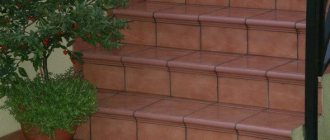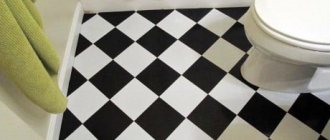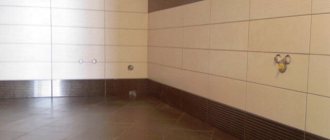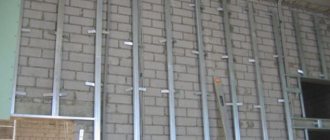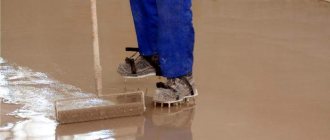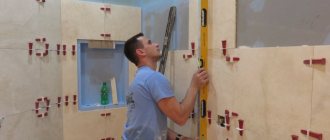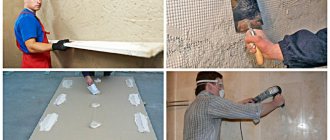If you once spend a couple of days laying tiles on the floor in the kitchen, it will last you 10-15 years of use. Due to its low cost, practicality and exceptional moisture resistance, this material is considered the best solution for rooms with high humidity and load. In the last article we talked about how to make a tile apron, and now we’ll look step by step at how to lay tiles in the kitchen correctly.
The choice of floor tiles for the kitchen depends on whether you want a solid color or pattern, whether you prefer the quality of foreign materials, or whether inexpensive Russian tiles are more suitable for you. In this article, finishing will be done using the example of Ukrainian relief stone tiles from Inter Cerama measuring 35*35 cm (BARI collection in light brown color).
Tools and materials for laying tiles on the floor
To lay floor tiles, you will need:
- Rubber hammer;
- Tile adhesive;
- Bubble level;
- Grinder with diamond blade;
- Pencil, tape measure, painting cord;
- Spatula – standard and comb with 12 mm teeth;
- Rubber grout and spatula;
- Deep seepage soil;
- Brush or roller for soaking with primer;
- Plastic blades and 3 mm crosses for seams;
- 2 meter level or rule for plane measurements.
The initial stage of laying tiles
Before installation begins, the base of the floor is prepared for the future tile covering. Before installation, you will need to remove the aged coating and level the base if necessary.
When the difference in height is no more than 10 mm, then such unevenness can be compensated for by applying a larger amount of adhesive. But when there is a larger surface difference, you will need to make a screed to remove it.
The presence of a leveled base will make it easier to carry out work and reduce the consumption of the adhesive mixture. Also, the tiles will not crack due to uneven drying of the glue (it hardens at different speeds when the layer differs in thickness).
In such a situation, it is not recommended to simplify everything even before laying floor tiles in the kitchen - a screed with water insulation is created.
Preparation of the adhesive composition
The glue is diluted in a container by adding water, based on the proportion indicated in the instructions on the pack. The mixture should be stirred constantly using a hammer drill, mixer or drill with a special whisk attachment.
The result should be glue with a consistency reminiscent of thick sour cream. Let it sit for 10 minutes (or according to the manufacturer's instructions). The composition is mixed before application.
Calculation of the number of tiles
In order to find out the number of floor tiles, you should make calculations, taking into account the cutting distance:
- Having chosen a single-color design, you need to calculate the square footage of the floor and add 10% to it.
- The resulting numbers must be divided by the area of 1 piece of tile and the desired result should be obtained.
- When the dimensions of the tiles are known, you need to lay out the tiles in the kitchen on the floor.
- To understand the whole picture, you can schematically depict the floor to scale.
- When you choose the type of floor for tiles with relief, the amount of waste increases greatly.
It is worth remembering that laying floor tiles in the kitchen is done with seams; otherwise, the cut item runs the risk of not fitting into the niche.
Layout features
Depending on the size of your kitchen, what design project you have planned and how the furniture will be arranged, you should choose the tiles that will decorate the kitchen floor.
A large kitchen will accept both large and small tiles well; in medium and small kitchens it is better to install large tiles. Due to the large slabs, the floor space will not be crowded in the eyes, and due to the reduced number of slabs, the floor will seem more solid (almost self-leveling). If the layout of the kitchen is such that there will be a culinary island in the middle or the kitchen is narrow, then it is better to lay darker tiles under it. It is also better to place dark tiles where the dining table will be located, this creates the effect of the presence of a carpet and this brings additional comfort.
Since the kitchen is one of the most frequently used and functional rooms in the house, floor tiles must be of high quality and meet wear resistance class 3 or 4.
You can choose an even higher 5th class, which will cost much more than the above, but will retain its presentation longer.
In a large space with a non-standard layout, tiles laid asymmetrically will look good; they will give such a kitchen an additional zest.
Tile marking
We provide the progress of processes for upcoming work:
- From the wall near the entrance to the room, measure a gap corresponding to the width of the selected tiles with an allowance of 5 mm for the gap (this will then be covered by the baseboard).
- A paint cord is pulled along the markings to mark a line under the first row of slabs.
- For laying in one direction, there are indicator arrows on the other side of the products; they will not look out under the ball of glue, so marks are made on the edge of the tiles using a pencil.
- A mark is made in the center of the entrance to the kitchen, and for orientation, a tile devoid of adhesive mixture is placed there.
Linoleum
When deciding which floor to make in the kitchen with their own hands, many owners of apartments and country houses choose affordable, easy-to-use linoleum. Modern production technologies, the use of reliable and safe materials today make it possible to obtain a high-quality and durable product, which in its functional and aesthetic indicators is not inferior to alternative coatings.
Linoleum compares favorably with its competitors:
- wear resistance;
- hygiene;
- ease of installation;
- wide choice of colors;
- low cost.
Arranging such a kitchen floor is accessible to everyone. The material is easy to care for and easy to clean from dirt - the synthetic coating is resistant to abrasion and water.
By giving preference to the middle price segment, you don’t have to worry about damage to the surface due to the fall of heavy, sharp objects or exposure to hot grease drops.
In this case, it is better to avoid the accumulation of puddles on the surface; spilled liquid should be wiped dry with a soft cloth to avoid deformation of the material.
The advantages of linoleum include the ability to imitate almost any natural material. This floor can take the form of natural wood, marble, granite, cork, oak parquet or ceramic slab.
Laying tiles on the floor in the kitchen (step by step instructions)
The adhesive is applied to the tiles evenly using a regular spatula. Then you need to run a comb along it, maintaining a right angle, so that you get equal grooves of glue.
- Excess glue is dumped into a bucket, and the spatula should be placed in a bucket of water so that the glue does not stick to it.
- The first tile lies on the right side of the lighthouse laid before. The edges are brought together and pressed to the floor. Then you need to check the evenness with a short level.
- When one of the edges is placed unevenly, then you need to tap it with a rubber hammer, then the level again checks the evenness.
- Laying occurs further to the right side of the lighthouse. Plastic crosses are placed between the plates. Before inserting the cross, it is recommended to run it along the crack, removing excess glue, because when it dries, this will be difficult to do. To prevent the tiles from moving to the side of the wall, plastic wedges must be inserted there.
- The laying of the first row of slabs in the right direction is completed and the overall evenness is checked by using an extended level. When this is not available, a flat profile up to 2 meters with a small bubble level will do.
- If unevenness is identified, then you have 15 minutes after application to carefully lift the uneven tiles and apply mortar or remove excess mixture. If it takes a long time and the glue has hardened, then you will have to remove the tile and scrape off the mortar underneath.
- Near the wall, you may need to cut off the edge of the slab. High-quality tiles are much harder than wall tiles and it is better to cut them with a grinder with a diamond, smooth disk or a tile cutter powered by electricity.
- The trimmed slab is laid and the left-side row from the kitchen door is completed.
- The second row also originates from the lighthouse tile at the door entrance and must be laid on both sides of it. Each tile is checked according to its level and moved to adjacent corners.
- When the master approaches the pipes, cutouts are made in the tiles using a grinder for them. Sometimes you need to make round holes, for this you use special attachments on a drill, in the form of a crown or a ballerina.
Upon completion of the work, the floor surface is once again checked with an extended level for evenness in all directions. If everything is great, then after a day the seams are cleaned of traces of glue and filled with grout of a matching color.
After half an hour, excess grout is removed with a wet sponge, and after another 24 hours, the surface of the tile is completely washed of stains and is now ready for use.
Grouting joints
The main functions of such compositions are: increasing the attractiveness of the tile covering, sealing the finish. To make the grout highlight the tiles, materials of light contrasting colors are used. You can get the appearance of a monolithic floor by using a mixture of the same tone as the finishing material. A rubber spatula is used for this work. It is flexible, so it better fills the pores and smallest leaks with the grout mixture. As a result, the coating becomes more attractive. It is better to clean the tile surface from grout immediately after applying it.
Sealing
Instructions for performing the work:
- take a portion of the mixture and apply it to the seam area;
- the solution must be distributed evenly using a rubber spatula, while pressing on the tool;
- when the gap between the two tiles is filled, a cable of a sufficiently large cross-section is placed on top, which will make it possible to make a recess.
You can start grouting the next day after finishing installation of the finishing material. If you start work earlier, the coating may become deformed, and its service life will be significantly reduced. Proper grouting ensures the tightness of the floor surface.
Kitchen tile design options
- For a small kitchen, a floor made of light-colored tiles is suitable, because it will bring light into the kitchen and the room will visually become more spacious. The dark shade of the tiles will only indicate the small dimensions of the kitchen. Even when the area is large, a dark floor needs to be balanced with light-colored furniture and wallpaper.
- When kitchen windows face north or west, a single-color finish in warm, light colors will be more suitable for the floor. And for kitchen windows facing south, tiles of bright, cool colors are suitable.
In a kitchen in the direction of minimalism or hi-tech, the best choice would be a single-color floor or tiles with a very calm and discreet design. A kitchen in a classic style will be wonderfully complemented by ceramics with Hellenistic patterns or marbled tiles.
And the country and Provence style will be perfectly completed by a floor laid with deliberately outdated ceramics, imitation of cotto slabs, or variegated ceramic, or metlakh tiles, or a copy of them
Among the varieties of floor tiles, there are many sets with natural colors; brown, gray and beige shades are also present. These colors have one advantage - they do not stain and therefore are perfect for the kitchen.
